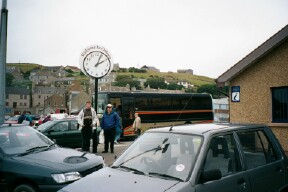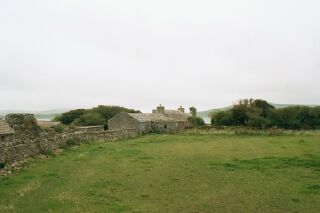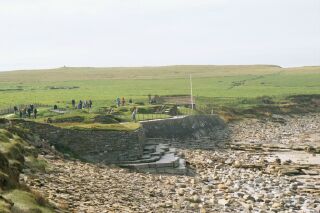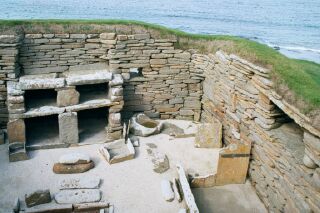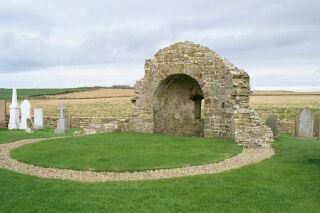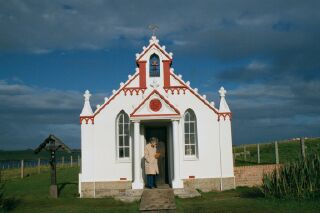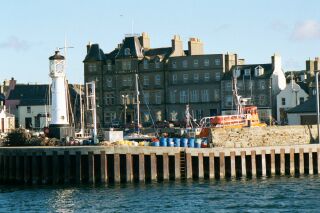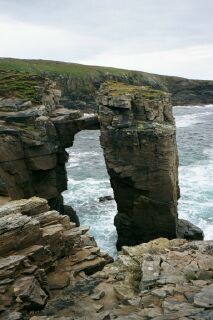Orkney Islands
September 10, 2001
The Clan headed north from Wick to John O'Groats, one of the most northern points on mainland Scotland, and one from which we could see the Orkney Islands across the Pentland Firth. Many photos were taken of the "last house in Scotland." We then traveled west through Thurso to Scrabster on Thurso Bay.
The Clan was met by our kinsman James Irvine of Surrey, England, whose Irvine ancestors had lived in the Orkneys. James with his knowledge of history and genealogy served as our guide, mentor and friend during our 5-day visit to the Orkneys. The Clan plus our bus took the 2-hour ride on the P&O Ferry "St. Ola" from Scrabster past the island of Hoy with its "Old Man of Hoy," a 400 ft. rock stack, to Stromness on Mainland Orkney. The Clan took lunch on the ferry with some of the party getting their first taste of that wonderful Orkney ice cream.
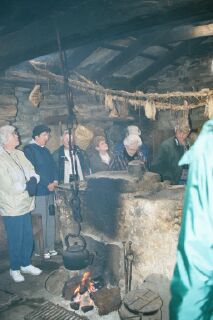
We toured the Ring of Brodgar, a stone circle originally containing 60 megaliths and now with 36 remaining upright. It is part of The Heart of Neolithic Orkney World Heritage Site. After checking into the Kirkwall Hotel on Harbour St., our home for four nights, we walked through Kirkwall to St. Magnus Cathedral, built by Magnus' nephew Rognvald Kolson and consecrated about 1150. This beautiful old red sandstone cathedral belongs to the people of Kirkwall and Orkney. The Clan toured the cathedral with assistant Curator Ingrid Jollie and James Irvine who pointed our several Irving tombstones and a stained glass window bearing the Irving holly leaf.
September 11, 2001
Sheena Wenham served as our guide for a tour of the West Mainland historic sites. We began with the Broch of Gurness, a late Iron Age settlement-Last Century BC/First Century AD-occupied for hundreds of years. We traveled past the Brough of Birsay with remains of early Christian and Norse settlements to Birsay where we viewed ruins of the 16th Century Earl's Palace, built by Robert Stewart, half-brother of Mary, Queen of Scots, and St. Magnus Church, Birsay.
This Church, built on the site of the original Christchurch, was built about 1064 and is believed to be the original burial site of Magnus Erlendson, whose bones are believed to rest now in St. Magnus Cathedral in Kirkwall.
We next
toured the Kirbuster Farm Museum composed of several buildings
and rooms that depicted various time periods. Especially interesting
was the “fire hoose” that had no chimney but had
an open fire with a “fireback,” smokehole in the
roof, beds built into the stone wall, a “neuk-bed,”
and codfish hanging from straw ropes and being smoked over
the fire.
Overlooking
the Bay of Skaill, this housing colony was buried for 4500
years until a wild storm in 1850 stripped off the grass and
sand to uncover the midden heap and the dwelling structures.
It was both beautiful and awesome.
Nothing could be in sharper contrast to Skara Brae than the next building
we visited, 17th Century Skaill House considered “the
finest mansion in Orkney” and standing about 200 yards
from Skara Brae. The Clan was very fortunate to tour Skaill
House with the 12th Laird, Major Malcolm Macrae and with James
Irvine, who wrote the “official” guide book to Skaill
House.
The Clan
then split into two groups with one group going with James
Irvine on a two-mile cliff-top walk viewing Irvine/Irving
country, Yescanabie castle, etc. The rest of the Clan visited
Orphir to see an audiovisual presentation of the Orkneyinga
Saga and to view Orphir Church, ruins of Scotland's only Medieval
Church which was constructed in the first part of the 1100s
and dedicated to St. Nicholas.
As they
returned to the bus from these expeditions, Clan members learned
of the 9-11 tragedy in the USA. (Scotland is 5 hours ahead
of the Eastern Time Zone.) The day ended with a return to
the Kirkwall Hotel and everyone watching developments on BBC
television and attempting to contact family and friends in
the USA.
September 12, 2001
The morning was
free in Kirkwall. Most Clan members revisited St. Magnus Cathedral
and/or toured the Mid-12th Century Bishop's Palace, the 17th
Century Earl's Palace and the Orkney Museum in Tankerness
House, whose exhibits included mounted puffins, bog butter,
tartan that had been buried in a bog, rocks with Pict carvings,
rune stones along with pre-historical and historical artifacts
excavated from various archeological sites.
After lunch the
Clan boarded the bus to go to the Highland Park Distillery.
We were greeted by the Highland Park cats, an orange-marmalade
named Barley and a grey-brown tiger named Malt. The Distillery
tour included all aspects of producing single malt scotch
whisky and the opportunity to taste a wee dram. We then visited
the Italian Chapel which was built during WWII by Italian
POWs. Orkney is known for arts and crafts based on its historic
sites and beautiful scenery.
The Clan had the
opportunity to make two of the stops on the “Orkney Craft
Trail.” We visited the Sheila Fleet Jewellery Workshop
in Tankerness to see her Orkney-inspired jewellery being made.
We also toured “The Workshop” in St. Margaret's
Hope, a craft producers' co-op specializing in high quality
knitwear and crafts. The evening was spent in St. Margaret's
Hope visiting The Smiddy (Blacksmith) Museum, walking around
the town and observing at least seven cats and enjoying dinner
at the Creel Restaurant.
